Lab Automation in Drug Discovery Market Size
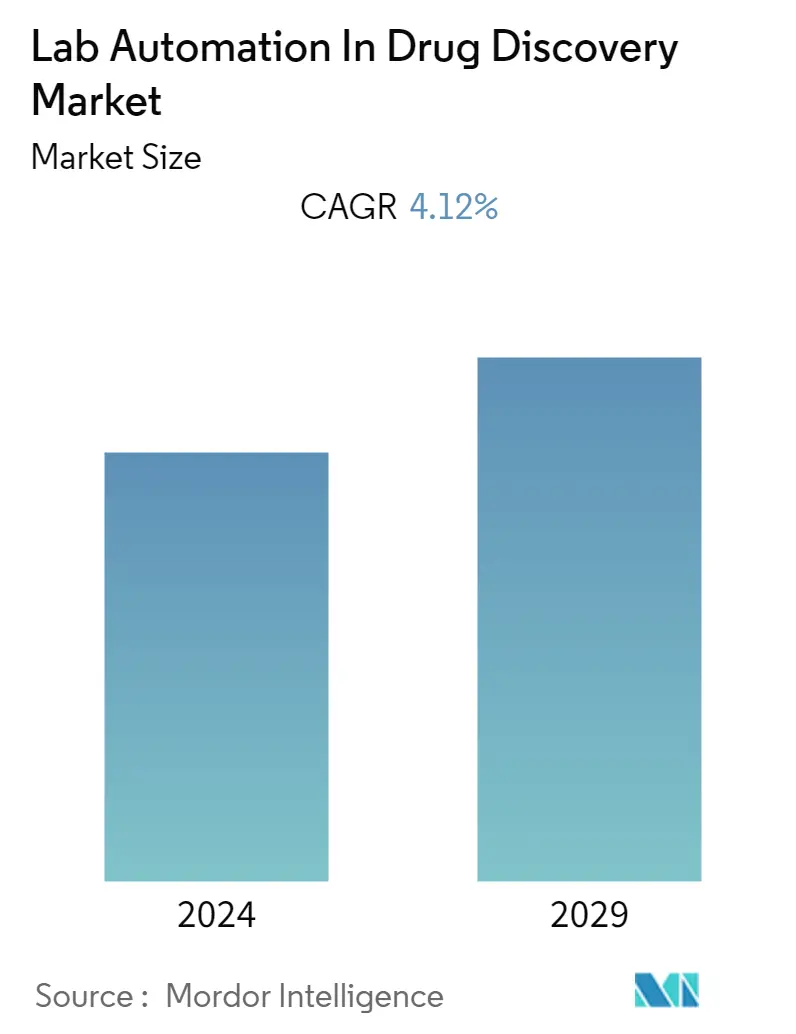
| Study Period | 2019 - 2029 |
| Base Year For Estimation | 2023 |
| CAGR | 4.12 % |
| Fastest Growing Market | Asia-Pacific |
| Largest Market | North America |
| Market Concentration | Medium |
Major Players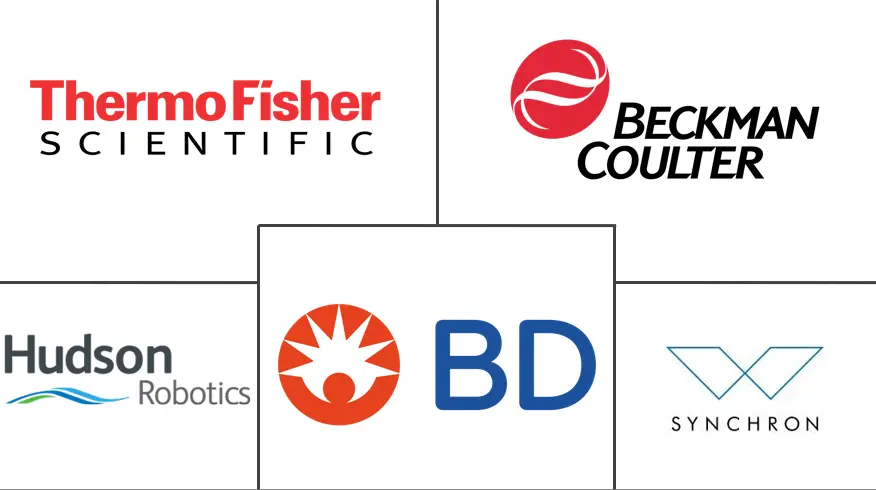
*Disclaimer: Major Players sorted in no particular order |
Lab Automation in Drug Discovery Market Analysis
Lab automation in the drug discovery market was valued at USD 5.55 billion in the previous year and is expected to reach USD 7.28 billion while registering a CAGR of 4.12 percent during the forecast period. Drug discovery organizations have been investing massive amounts in R&D activities to develop new technologies that are expected to enhance their products. These companies invest in proteomics, drug testing, high-throughput screening, and combinational chemistry to develop an environment-friendly biotechnology reagent. Hence, such developments are expected to contribute to the growth of the market over the forecast period.
- Laboratory automation transformed drug discovery over the years, primarily through two major influential factors: error reduction and cost-benefit. Additionally, automation transformed the traditional drug discovery process by making it feasible to identify many targets through the biotechnology revolution and numerous combinatorial technologies, which fueled compound collection. Additionally, drug research companies require complete solutions, dedicated customer care, and realizing their value for huge investments. Furthermore, research laboratories expect maximum software flexibility so they can configure it themselves.
- The United States has been a pioneer in clinical research for years. This country is a hub for some prominent pharmaceutical companies, like Pfizer, Novartis, J&J, GlaxoSmithKline, and Novartis. The country also possesses the highest contract research organizations (CROs) concentration. Some of the significant CROs in the country are IQVIA, Laboratory Corp. of America Holdings, Syneos Health, and Parexel International Corp. Due to the presence of such prominent players in the industry and stringent FDA regulations, the studied market is very competitive in the country. Companies in the country are adopting robotics and automation in labs to gain an advantage over competitors.
- Furthermore, the journey in drug discovery laboratories has inclined to focus on speed and accuracy. Therefore, automation of biological assays is becoming the primary factor for HTS as the labs are mainly required to screen a large number of compounds, approximately 1-3 million.
- However, one of the significant challenges that act as a hurdle in the uptake of automation in pharmaceuticals has been the interdisciplinary nature of the problem. For instance, expertise in traditional chemometrics analysis is needed, as well as advanced instrumentation, potentially new sampling or robotics methods, and knowledge of the most recent developments in machine learning (ML) and artificial intelligence (AI) approaches. In addition to this, the use of automation in laboratories can result in issues with compliance and regulations as automation can introduce errors or incorrect data into the lab environment, further increasing the probability of potential for incorrect results or non-compliance with regulations.
- On the contrary, the pandemic positively impacted the need for lab automation in drug discovery laboratories. The spread of COVID-19 and SARS-COV-2 increased the pressure on drug manufacturers to develop vaccines to combat the spread of the virus across the world. Therefore, the production contracted with major COVID-19 vaccine players increased for players, including Moderna, Johnson & Johnson, & AstraZeneca, and Catalent. Thus driving the demand for lab automation across vaccine drug manufacturers.
Lab Automation in Drug Discovery Market Trends
Automated Liquid Handlers are Expected to Account for the Largest Market Share
- Liquid handlers are generally employed in biochemical and chemical laboratories. The need for high throughput screening in the drug discovery sector is increasing and is driving the demand for liquid handlers. However, miniaturization is becoming one of the main factors in drug discovery as the lab space is one of the most accountable factors for laboratories globally.
- The cost per square foot for laboratories is rising in major technology hubs. Researchers and scientists are focusing on instrumentation that takes a smaller amount of space and provides optimal performance. One such example of the miniaturized liquid handler is the flexi liquid handling platform, which is designed to combine with multiple systems, such as the robotic arm, stackers, and multiple systems, among others.
- Therefore, such platforms are increasing cost savings as there is an increased reduction in reagent volumes used in high throughput screening. Furthermore, the availability of reagent volumes in drug discovery is limited, and the automated liquid handlers are helping end users in large-scale screening with lower volumes of reagents.
- Vendors in the market have been introducing new automated liquid handlers to meet the requirements of modern laboratories established for drug discoveries. For instance, in February 2022, SPT Labtech announced the launch of their apricot DC1 platform, which serves 4-in-1 automated liquid handling specifications. The platform incorporates four separate pipetting tools in a single benchtop unit to enable dual-core pipetting technology for low-volume, high-volume, single, and multichannel pipetting used during drug discoveries.
- Furthermore, apart from miniaturization, automated liquid handlers are being proven to improve lab standardization by automating sample tracking and Laboratory Information Management Systems integrations. In addition, the liquid handlers facilitate the incorporation of automated barcode scanning into every step of sample processing. Thus, it makes it easy for the users to proceed with predefined work orders and import data into their management systems without requiring manual recordings.
- Moreover, the growing complexities of screening assays in drug discovery are shifting the focus of end users to incorporate speed-based performance toward system-based flexibility and data integrity. In addition, one of the significant challenges in the manual liquid handling process is the ordering and timing of reagent additions and general volumetric performance (for handling assays). Therefore, vendors in the market are designing automated liquid handlers with positive displacement dispensing technology that enables time-course reagent additions.
- Furthermore, according to ClinalTrials.gov, the total number of registered clinical studies as of March 2022 is 409,300. Such increased focus on research and development is expected to drive the need for enhancing the automated liquid handlers equipment globally.
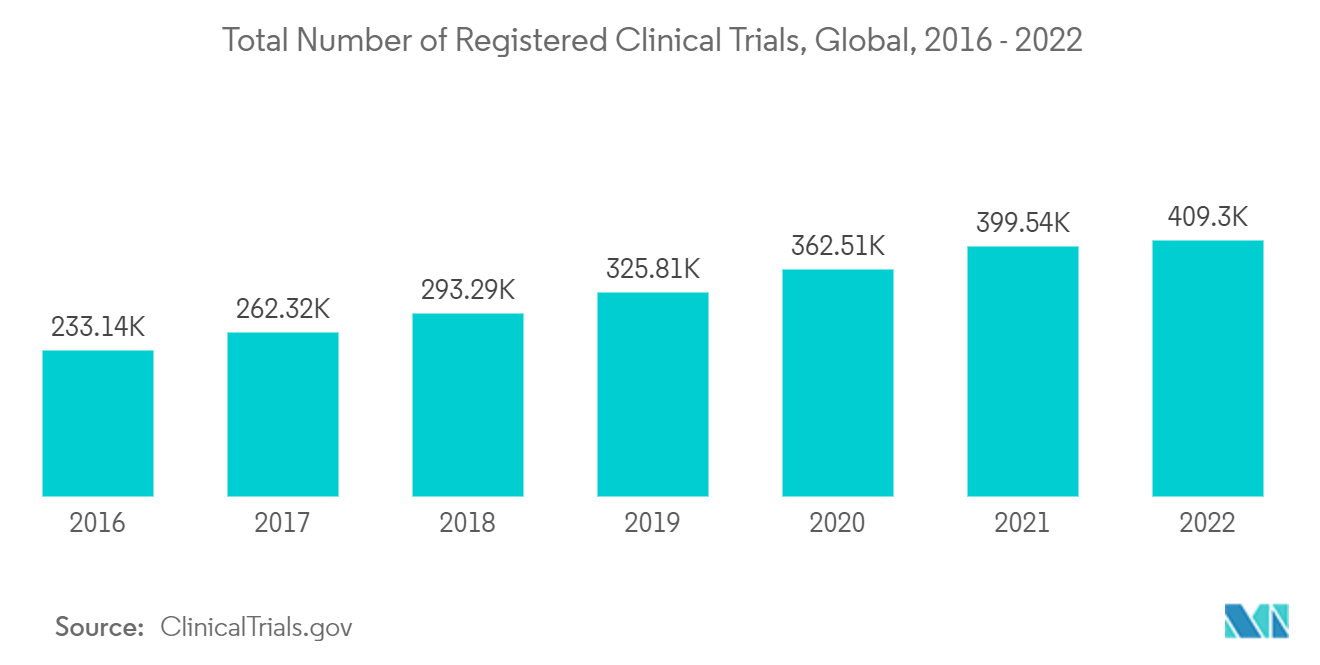
North America is Expected to Hold the Largest Market Share
- North America is anticipated to register a significant share due to the United States' presence, a country with significant investments in drug discovery. This country is home to some major pharmaceutical companies, like Novartis, Pfizer, GlaxoSmithKline, J&J, and Novartis.
- Moreover, with the presence of significant market players in the region, the investment in drug discovery is also enormous in the region. For instance, in July 2023, Pfizer and venture firm Flagship Pioneering announced investing USD 100 million together to develop up to 10 new potential drugs for areas including internal medicine, oncology, infectious diseases, and immunology. Under the terms of the agreement, Flagship-backed companies can receive about USD 700 million in milestones and royalties upon the successful launch and sale of any of the experimental treatments discovered and developed under the partnership. This adds up to the opportunity for the market studied owing to the presence of updated and automated labs by these market players to get desired outcomes.
- In addition to this, the growing number of drug approvals in the region also showcases the continuous evolution of drug discovery in the country, which presents the importance of proper automated labs that can lead to accurate results and faster outcomes with optimized operations. For instance, according to Nature Reviews Drug Discovery, in 2022, the FDA's Center for Drug Evaluation and Research (CDER) approved 37 novel drugs.
- The market is also witnessing growing investments in incorporating AI and machine learning technologies in drug discoveries, driving the need for lab automation in the region. For instance, Google DeepMind's AI technology developed the g DL algorithm to predict the 3D structure of proteins from primary sequences. In addition, Google also began the Innovation Lab project with Sanofi to improve drug discovery with emerging technologies.
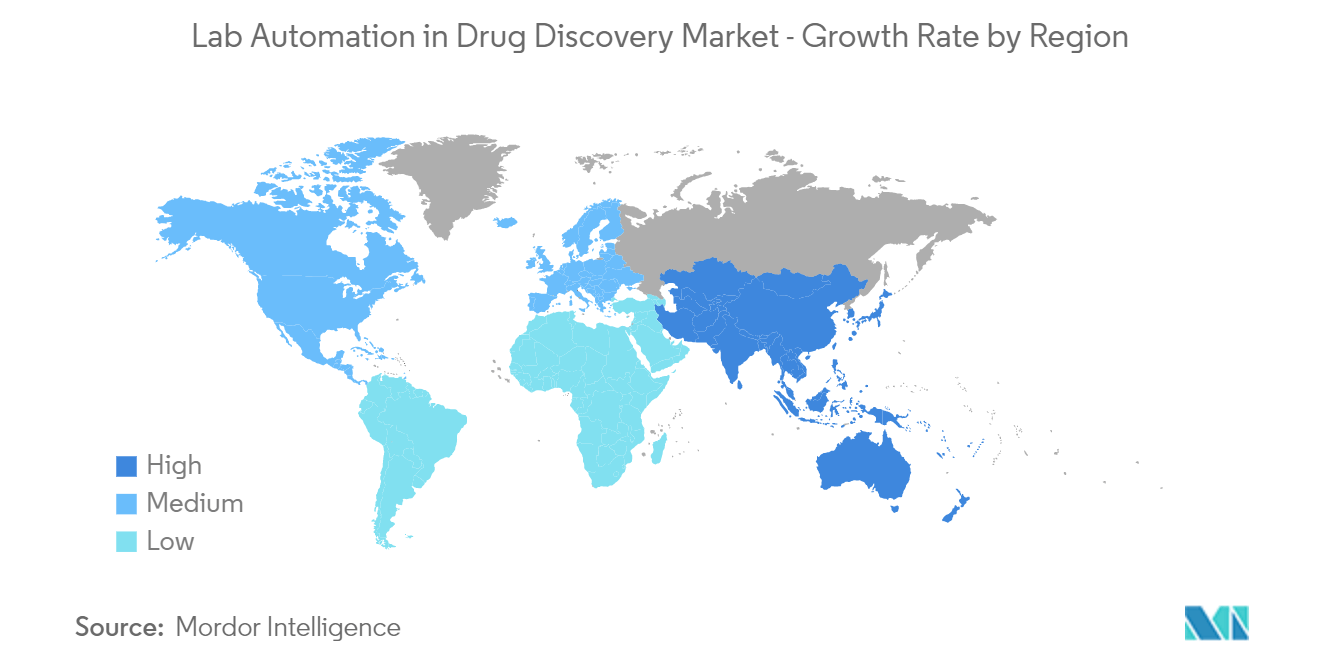
Lab Automation in Drug Discovery Industry Overview
The market offers strong competition to the operating players, owing to the presence of some key players in the market, such as Thermo Fisher Scientific, Beckman Coulter, and Synchron Lab Automation. Their ability to innovate their offerings has allowed the players to gain a competitive advantage over their competitors. These players can gain a strong foothold in the market through R&D activities, strategic partnerships, and mergers and acquisitions.
In February 2023, PerkinElmer unveiled two new solutions aimed at next-generation screening and high-throughput screening (HTS) applications (NGS). The company unveiled its EnVision Nexus system, intended for demanding HTS applications and to hasten the drug development process. Due to the system's high-throughput, quick dual detectors, researchers can screen millions of samples more accurately, quickly, and sensitively. The company has made it possible for the system to be totally automated and integrated for continuous process automation. The company also unveiled the Zephyr G3 NGS iQ workstation, an integrated benchtop system that permits the automated production of up to 96 NGS libraries. This workstation includes a high-performance liquid handler, an integrated thermocycler, a robotic arm, and all deck accessories and peripherals, allowing laboratories to automate even the most complex NGS methods with a higher level of reproducibility, thereby increasing capacity and reducing errors.
In February 2022, The I.DOT HT Non-contact Dispenser and the L.DROP Liquid Handler were unveiled at SLAS 2022, according to DISPENDIX, a BICO firm. Driven by the I.DOT non-contact Dispenser's growth over the past few years, DISPENDIX made strategic R&D investments and industry partnerships to develop two innovative platforms that would work together to give scientists more comprehensive workflow solutions for genomics and drug discovery research. The I.DOT HT expanded on the I.DOT's basic technology uses a 384-well source well configuration to manage chemical libraries at big pharma and more modest biotechnology firms.
Lab Automation in Drug Discovery Market Leaders
-
Thermo Fisher Scientific
-
Beckman Coulter
-
Hudson Robotics
-
Becton Dickinson
-
Synchron Lab Automation
*Disclaimer: Major Players sorted in no particular order
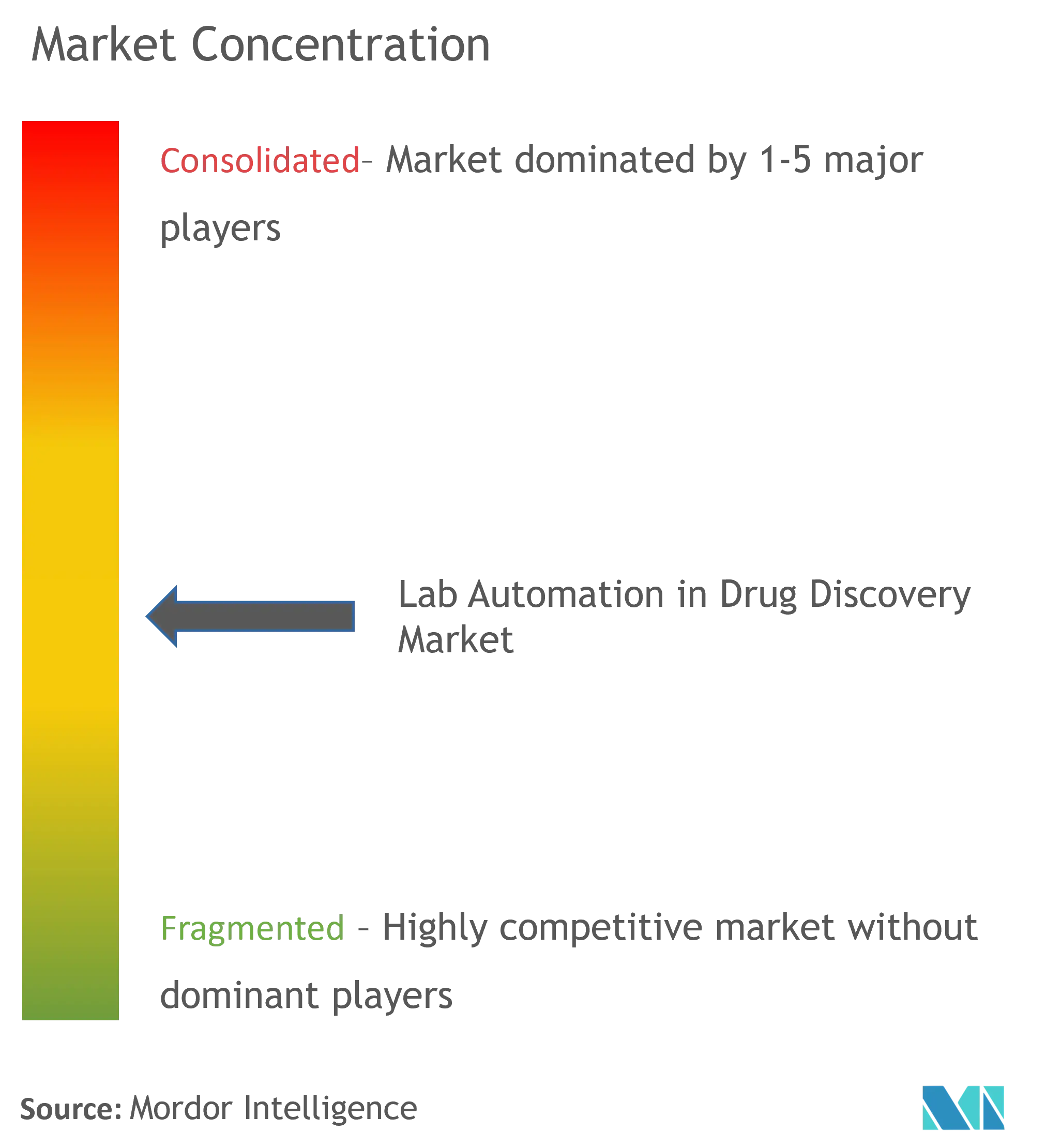
Lab Automation in Drug Discovery Market News
- March 2023: Eppendorf announced the release of the new generation of the epMotion automated liquid handler at the 2023 SLAS conference in San Diego, CA, USA. The epMotion offers unparalleled precision and accuracy in liquid handling, with a user-friendly interface and customizable protocols. The new design includes a sleek, compact form and improved ergonomics for comfortable and efficient use.
- February 2023: Automata announced the launch of an integrated laboratory automation platform named LINQ that features a laboratory bench with integrated automation capabilities and accompanying powerful, proprietary lab orchestration software. The LINQ bench robotically connects instruments using a robot arm and a transport layer, both of which feed labware and consumables throughout the workflow. This setup helps to increase the throughput of a lab as benchtop instruments can be used at maximum capacity.
Lab Automation in Drug Discovery Market Report - Table of Contents
1. INTRODUCTION
- 1.1 Study Assumptions and Market Definition
- 1.2 Scope of the Study
2. RESEARCH METHODOLOGY
3. EXECUTIVE SUMMARY
4. MARKET INSIGHTS
- 4.1 Market Overview
-
4.2 Industry Attractiveness - Porter's Five Forces Analysis
- 4.2.1 Bargaining Power of Suppliers
- 4.2.2 Bargaining Power of Buyers
- 4.2.3 Threat of New Entrants
- 4.2.4 Threat of Substitute Products and Services
- 4.2.5 Intensity of Competitive Rivalry
- 4.3 Industry Value Chain Analysis
- 4.4 Assessment Of Impact Of COVID-19 On The Market
-
4.5 Technology Overview
- 4.5.1 Technology Snapshot
- 4.5.2 Industry Applications
5. MARKET DYNAMICS
-
5.1 Market Drivers
- 5.1.1 Technological Innovations Leading to Device Miniaturization and Increased Throughput
-
5.2 Market Challenges
- 5.2.1 Slower Rate Of Adoption In Small And Medium Scale Labs
6. MARKET SEGMENTATION
-
6.1 By Equipment
- 6.1.1 Automated Liquid Handlers
- 6.1.2 Automated Plate Handlers
- 6.1.3 Robotic Arms
- 6.1.4 Automated Storage & Retrieval Systems (AS/RS)
- 6.1.5 Software
- 6.1.6 Analyzers
-
6.2 By Geography
- 6.2.1 North America
- 6.2.2 Europe
- 6.2.3 Asia-Pacific
- 6.2.4 Rest of the World
7. COMPETITIVE LANDSCAPE
-
7.1 Company Profiles*
- 7.1.1 Thermo Fisher Scientific
- 7.1.2 Beckman Coulter
- 7.1.3 Hudson Robotics
- 7.1.4 Becton Dickinson
- 7.1.5 Synchron Lab Automation (MolGen)
- 7.1.6 Agilent Technologies
- 7.1.7 Siemens Healthcare
- 7.1.8 Tecan Group Ltd.
- 7.1.9 Perkinelmer
- 7.1.10 Bio-Rad
- 7.1.11 Roche Holding AG
- 7.1.12 Eppendorf AG
- 7.1.13 Shimadzu
- 7.1.14 Aurora Biomed
8. INVESTMENT ANALYSIS
9. MARKET OPPORTUNITIES AND FUTURE TRENDS
** Subject To AvailablityLab Automation in Drug Discovery Industry Segmentation
The use of instrumentation to perform laboratory activities with minimum human involvement is known as lab automation. Automation can be used for any part of an experimental process, from a single step to the full workflow. Lab automation is divided into three stages: pre-analytical, analytical, and post-analytical. Automated processes can be applied to all aspects of the experimental process.
Lab automation in the drug discovery market is segmented by equipment (automated liquid handlers, automated plate handlers, robotic arms, automated storage and retrieval systems (AS/RS), software, and analyzers) and by geography. The market sizes and forecasts are provided in terms of value in USD for all the above segments.
| By Equipment | Automated Liquid Handlers |
| Automated Plate Handlers | |
| Robotic Arms | |
| Automated Storage & Retrieval Systems (AS/RS) | |
| Software | |
| Analyzers | |
| By Geography | North America |
| Europe | |
| Asia-Pacific | |
| Rest of the World |
Lab Automation in Drug Discovery Market Research FAQs
What is the current Lab Automation in Drug Discovery Market size?
The Lab Automation in Drug Discovery Market is projected to register a CAGR of 4.12% during the forecast period (2024-2029)
Who are the key players in Lab Automation in Drug Discovery Market?
Thermo Fisher Scientific, Beckman Coulter, Hudson Robotics, Becton Dickinson and Synchron Lab Automation are the major companies operating in the Lab Automation in Drug Discovery Market.
Which is the fastest growing region in Lab Automation in Drug Discovery Market?
Asia-Pacific is estimated to grow at the highest CAGR over the forecast period (2024-2029).
Which region has the biggest share in Lab Automation in Drug Discovery Market?
In 2024, the North America accounts for the largest market share in Lab Automation in Drug Discovery Market.
What years does this Lab Automation in Drug Discovery Market cover?
The report covers the Lab Automation in Drug Discovery Market historical market size for years: 2019, 2020, 2021, 2022 and 2023. The report also forecasts the Lab Automation in Drug Discovery Market size for years: 2024, 2025, 2026, 2027, 2028 and 2029.
Lab Automation in Drug Discovery Industry Report
Statistics for the 2024 Lab Automation in Drug Discovery market share, size and revenue growth rate, created by Mordor Intelligence™ Industry Reports. Lab Automation in Drug Discovery analysis includes a market forecast outlook 2029 and historical overview. Get a sample of this industry analysis as a free report PDF download.



